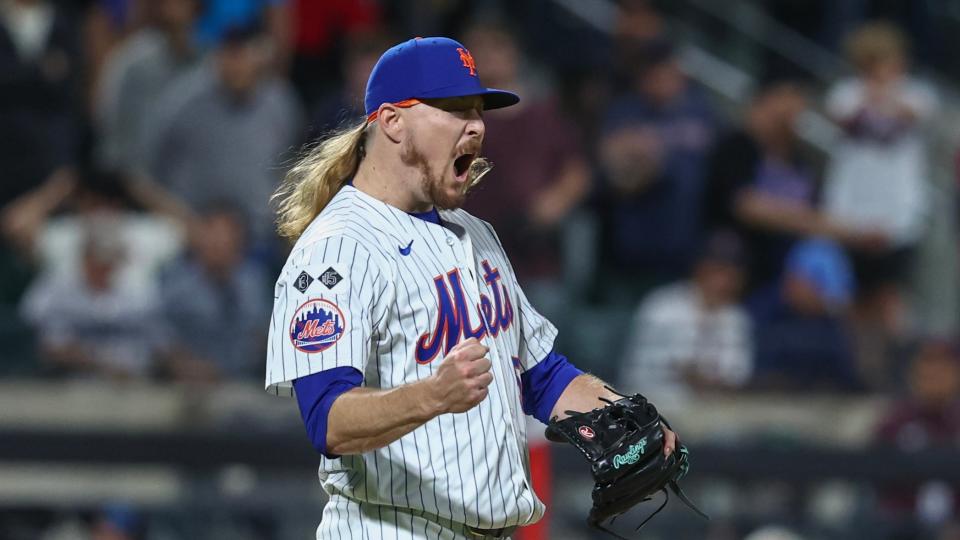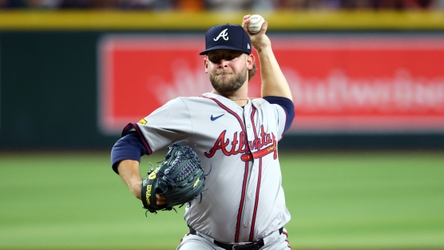The Mets assured themselves of a good grade for their offseason the moment they lured Juan Soto away from the Yankees. The only question was how good?
The most recent moves — signing Ryne Stanek, A.J. Minter and Jesse Winker — have added much-needed pieces for the bullpen and bench/DH, yet a final grade can’t be assigned until the Pete Alonso saga is settled one way or another.
Such is Alonso’s potential impact on a lineup that looks a bit light on thump without him.
In the meantime, however, we’re keeping a running account of the offseason moves, grading each one individually with the team grade still to come. Here is the latest installment…
Juan Soto
(Signed to a 15-year, $765 million contract)
The enormity of the deal is still rather staggering, especially considering there’s a pretty good chance the total goes to $805 million in five years when the Mets can void an opt-out in the contract by guaranteeing another $40 million over the final 10 years.
Yet it’s worth it for the Mets, not only to get such a difference-making hitter at the tender age of 26, but to outbid the Yankees and electrify the fans who have long been frustrated at the perception their team is the little brother in the intra-city rivalry.
The Mets will have to win championships to make the new perception a reality, and in baseball one superstar can only do so much. But if Soto continues on his Hall of Fame track he’ll significantly increase the odds.
GRADE: A+ (Duh)
Sean Manaea
(Signed to a reported three-year, $75 million deal)
This is an excellent deal for the Mets in a market where the prices for starting pitching have been very high. The key was limiting the term to three years when it seemed very possible, based on what others were getting, that the Mets might have to extend to four years to keep Manaea.
It’s still a leap of faith to some degree, at $25 million per year, that the left-hander’s dominance in the second half last season is sustainable at age 32, especially considering the inconsistent nature of his career.
But there’s a strong consensus from scouts that I’ve spoken to that what Manaea did was no fluke, as the change to a Chris Sale-like delivery, with a lower arm angle, turned his fastball into a swing-and-miss pitch at the top of the strike zone.
“There’s deception that’s real because of the lower arm angle,” said one scout. “The ball gets on hitters faster than their eyes are telling them. And he has other weapons that hitters have to honor.”
GRADE: A
A.J. Minter
(Signed to a two-year, $22 million contract with an opt-out)
The Mets desperately needed a proven left-handed reliever, and Minter has been one of the more consistent setup men in the majors over the last several years. Taking him away from the Atlanta Braves, for whom he was a key bullpen piece, adds bonus points to the deal.
The only concern, which knocks the grade down a tick, is that Minter had a hip injury last season that limited him to 34.1 innings and ended his season in August, when he had surgery to repair a torn labrum.
With that in mind, at that price, I thought it made more sense to sign Kirby Yates, a right-hander who dominates lefties with his splitter — as well as righties. But maybe Yates preferred the Dodgers, who signed him for $13 million. In any case, Minter should prove valuable in setting up Edwin Diaz.
GRADE: A–


Ryne Stanek
(Signed to a one-year contract worth between $4-5 million)
Bringing back Stanek after he got some big outs in the postseason for the Mets is at the very least a solid and relatively inexpensive move that adds another late-inning reliever to the mix with Diaz and Minter. And if it helps give the Mets wiggle room to make a deal with Alonso, the Stanek signing becomes that much more significant.
As it was, the Mets were considering another top-tiered reliever such as Kenley Jansen, who would have been more costly and may well have made an Alonso signing less likely.
We’ll see about that. But Stanek should be a solid asset. He was having a mediocre season in Seattle when the Mets got him at the trade deadline, and he struggled early in his time in Queens. But from there he said he made a couple of important mechanical tweaks and largely found the form that made him a force with the Houston Astros during their heyday.
GRADE: A-
Jesse Winker
(Signed to a one-year, $7.5 million contract)
Some important hits in both the regular and postseason paved the way for a return to Queens, as Winker stamped himself as a clutch presence during his three months with the Mets.
His regular season numbers were mediocre after coming from the Washington Nationals at the trade deadline, but Winker delivered in some key at-bats, especially in the NLCS. He also played with the type of emotion and intensity that made him a favorite among teammates and fans.
That and a career .841 OPS against right-handed pitching potentially makes Winker an ideal lefty platoon partner in the DH role with the right-handed Starling Marte, as well as a good bat off the bench. He could even factor into the first base mix if Alonso doesn’t re-sign.
GRADE: B+


Clay Holmes
(Signed to a three-year, $38 million contract)
The Mets say they are committed to trying Holmes as a starter, which is intriguing if largely unpredictable since he has made only four starts in the big leagues — all of them in 2018 with the Pittsburgh Pirates.
Holmes has an elite sinker and high velocity that offers plenty of raw material for pitching coach Jeremy Hefner to work with, but he also has control problems at times that led to him losing his job as closer with the Yanks last season.
So we’ll see. If the conversion works the Mets get a solid starter at a below-market price. If not, they can return Holmes to the bullpen where he likely would play a major role in the late-inning mix.
GRADE: B
Frankie Montas
(Signed to a two-year, $34 million contract)
Do the Mets have a secret sauce in their new pitching lab? They got results last year in remaking Luis Severino and Manaea, but Montas could be more of a challenge, as he tries to get back to his above-average form of a few years ago before he underwent shoulder surgery.
His 4.84 ERA last season wasn’t encouraging, but he was better after being traded from the Cincinnati Reds to the Milwaukee Brewers at the deadline, and the Mets believe they can build on some of the changes Montas made in Milwaukee to make him at least a solid back-end starter in 2025.
At $17 million a year (with a player opt-out after 2025) the price seems high, but pitching is ultra-expensive all around the majors this offseason. At least it’s a short-term deal.
GRADE: C
Jose Siri
(Acquired in a trade with the Tampa Bay Rays for Eric Orze)
David Stearns essentially got a low-cost replacement for Harrison Bader, as Siri profiles as a superb defensive center fielder who doesn’t hit much. The 29-year-old does have some pop — 25 home runs in 2023 and 18 last season — but he hit only .187 with a .255 on-base percentage in ’24 as well.
During the Winter Meetings, Stearns said Siri likely will split time to some degree in center with Tyrone Taylor, who did a nice job last season as a backup.
Ideally for the Mets, Siri turns out to be something of a placeholder in center field until a top prospect such as Jett Williams or Drew Gilbert plays well enough in the minors to force his way into the big leagues at some point. But both are coming off injury-plagued seasons in the minors in 2024.
GRADE: C
#Mets #Offseason #Report #Card #Grading #key #move #including #bullpen #additions


